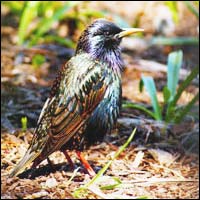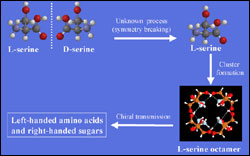Articles and reports from the Life Sciences and chemistry area deal with applied and basic research into modern biology, chemistry and human medicine.
Valuable information can be found on a range of life sciences fields including bacteriology, biochemistry, bionics, bioinformatics, biophysics, biotechnology, genetics, geobotany, human biology, marine biology, microbiology, molecular biology, cellular biology, zoology, bioinorganic chemistry, microchemistry and environmental chemistry.

Researchers in a University of Chicago lab are peering inside the minds of European starlings to find out how they recognize songs and in the process are providing insights into how the brain learns, recognizes and remembers complex sounds at the cellular level. In a study published in the Aug. 7, 2003, issue of Nature, the researchers show how songs that birds have learned to recognize trigger responses both in individual neurons and in populations of neurons in the bird’s brain.
“We found

It may be a right-handed world, but recent Purdue University research indicates that the first building blocks of life were lefties – and suggests why, on a molecular level, all living things remain southpaws to this day.
In findings that may shed light on the earliest days of evolutionary history, R. Graham Cooks and a team of Purdue chemists have reported experiments that suggest why all 20 of the amino acids that comprise living things exhibit “left-handed chirality,” which refe

Why are elephants bigger than mice? The main reason is that mice have fewer cells. Research published in Journal of Biology this week uncovers a key pathway that controls the number of cells in an animal, thereby controlling its size.
Ernst Hafen and his colleagues from the University of Zürich used fruit flies to investigate the role of the insulin-signalling pathway and in particular a molecule called FOXO. If insulin signalling is reduced, for example by starving developing fly lar

How did life begin? What chemical combination launched the first organism with self-contained metabolism? And then what happened? Researchers in Robert H. White’s group at Virginia Tech are tracing the family tree of life on earth by tracing the biochemical mechanisms within the cell – specifically those that are used in the formation of peptide bonds.
The building blocks of enzymatic and functional structures in living organisms are proteins created by linking amino acids into pepti

University of Michigan Kellogg Eye Center scientists have been studying a family whose members have an eye disease that looks like age-related macular degeneration (AMD), but that has a rarer pattern of inheritance that results in an exceptionally high incidence of the disease among family members in the study.
In the August issue of Investigative Ophthalmology & Visual Science (IOVS), Kellogg scientist Radha Ayyagari, Ph.D., and her collaborators from the U-M and other institutions identify

Scientists often look to nature for inspiration in the search for ways to make new materials. A new study of the clamworm, an intertidal creature, shows that it has jaws made partly of zinc, making them strong, stiff and tough –– fundamental properties by which all materials are evaluated.
The properties of the clamworm jaws are described in this week´s online publication of the Proceedings of the National Academies of Sciences (PNAS). The research began with questions by scientists a